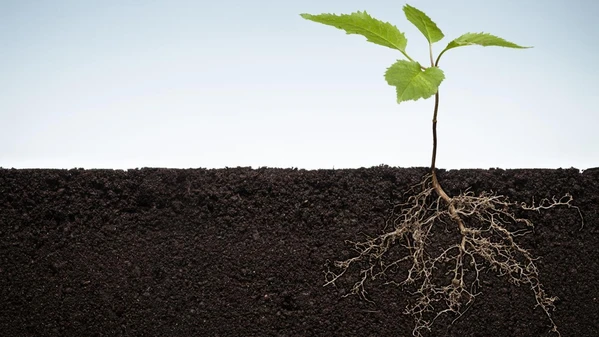Menu

FEED YOUR SOIL
Feeding my soil
What does that really mean?
Soil should be full of life, which is hard to see, as much of that life is microscopic. But your garden soil should be a thriving, living microcosm that is responsible for providing nutrients to your plants. If your soil is not alive, most plants will have a difficult time living, let alone thriving, in your garden. These microorganisms are responsible for unlocking all that your plants need from the soil, otherwise you are just gardening nothing more than ground up rock.
Factors that could reduce a soils effectiveness include intensive farming, construction and over use of commercial fertilizers. The soil in your garden is probably not the victim of intensive farming, but it could have been left there following construction, as fill or as inexpensive landscaping. And, if you live in area where commercial fertilizers have been over used your soil may also not have had a good balance of nutrients in the first place, or the required nutrients may have leached out over time. Sometimes we need to ameliorate our soil to optimize the plant’s growth, that is feeding your soil.
What are my options?
The current means of fertilizing, that actually grew out looking for a use for excess chemicals after the end of WWII, is to add to the soil the macro-nutrients that plants need and to hope that will be enough. These are the old familiar formula NPK - Nitrogen, Phosphorous and Potassium.
N Nitrogen promotes healthy leaf growth by stimulating the production of chlorophyll necessary for the conversion of sunlight to food.
P Phosphorus support the vigorous development of roots, stems, blossoms and fruits.
K Potassium plays a key role in helping plants digest and manufacture their foods.
How to read the numbers? NPK in that order
General purpose fertilizer: 20 20 20 - This is for balanced feeding. The number mean that 20 percent of the weight of the fertilizer is each element. The remaining 40 will be inert materials and trace elements. However, if you want to boost flower production: you may want a mix more like: 15 30 15. The higher middle number means more phosphorus, which will boost blossom production. Generally speaking, these types of formulas also include trace elements which also feed the plant: calcium, magnesium, iron, copper etc.
There are two types of applications possible:
Granular food which releases nutrients slowly over time and is placed in or on the soil. And water-soluble food that feeds the soil while you water.
People speak of organic fertilizers, what does that mean?
Organic fertilizers are derived from plants and animals Old standbys include animal manure and compost. And while these have long been used for garden enrichment, and are great for soil building, but depending upon their source and content they may not have the nutrients that are necessary for, or lacking in, your garden. Manure if taken directly from a farm, has known drawbacks as it may contain unwanted seeds that lead to weeds and grasses infiltrating your garden. Also insufficiently broken down manure may be too potent and burn plants in the garden. There is also the bagged variety of manure however these may have been sanitized to a degree that the wanted microorganisms have been removed. For flower and fruit development traditionally, gardeners have also relied on bonemeal which is high in phosphorus and blood meal which is a source of nitrogen. These would be applied according to the supplier’s instructions.
When should I apply fertilizer?
Whether using organic or chemical fertilizers most products recommend an application in the spring, but not in the rain, as the rain water will leach away the fertilizer. Heavy feeders may need applications twice in the season. Do not fertilize seeds or tiny seedlings as this may cause fertilizer burn. Some plants are considered heavy feeders: chrysanthemums, lupins, lilies, peonies, delphiniums, astilbe, phlox. Some do best without: Butterfly weed, false indigo, asters, monarda, speedwell, cone flowers and ornamental grasses.
Are there other options?
More recently, there has been a movement towards overall soil health, and unlocking the natural potential in your soil using living organisms. Coupled with that is the desire to use more natural products and organic methods of gardening. In this regard you could consider a mycorrhizal fungi product. It is used to inoculate the roots of your plants, at planting time, with fungi that form a beneficial network around the roots of the plant, bringing it nutrients. The hyphae (fungal filaments) are many times smaller than roots and grow hundreds of times faster. This allows the plants to tap into their absorptive capacity and grow stronger. The mycorrhizae solubilize and transport mineral nutrients in the soil back to the plant. Plants typically trade excess carbohydrates (sugar, starch) in return.
Plants in the City is happy to announce a new product in our catalogue to help optimize your garden soil. Root rescue is a mycorrhizal fungi product. Root Rescue is a product intended for use only at planting time so that the beneficial soil fungi go to work immediately helping your new plants, and the beneficial network you create will stay with your new plant for life. Once and Done!
You will use one 4.5 gram package of Root Rescue and mix it with 7.5 litres of water and use it to water in your new plants. One package should be enough for four to five plants. For a more detailed discussion, and to read about University of Guelph Efficacy Trials, go to https://www.rootrescue.com/site/home
Additionally Plants in the City has added a totally organic fertilizer to our catalogue: Acti-sol Fertilizers. Acti-sol does take more of a traditional fertilizer approach, but in the most basic unprocessed way possible, that is still feeding the soil and it's microbes. The Acti-sol pure hen manure product (Multipurpose Organic Fertilizer) that we have added to our line is just that, dried hen manure. 100% natural. It doesn't contain any fillers, soil, compost, sludge, binding agents or synthetic products and is approved for organic agriculture. It is a great, efficient, all purpose fertilizer and will give a boost to your newly planted perennials.
To use it, spread 1/4cup per 11 sq ft (or 40g/square meter) on the ground around established plants, or mix in 1/2 a cup with soil at planting time.
The second Acti-sol product (Perennial & Annual Flowers Organic Fertilizer) is a mix of hen manure, feather meal and potash sulfate, It is intended specifically for a more balanced all purpose fertilizer for perennials, annuals, roses, fruit trees, hanging baskets and balcony planters. It has a high organic matter content to improve water retention. Their recommendation is to use 2/3 cup per 11 sq ft (120g/square meter) for established perennials or annuals, or 1/3c per hanging basket. This can be repeated every 4 to 6 weeks throughout the growing season. You can read more about the Acti-sol line of products at their website. https://acti-sol.ca/en/
Nothing is perfect in this world, including the soil in your garden. These items are but two of the many items available to ameliorate the growing conditions of your garden. Each of them takes a slightly different approach to soil health. They can be used singly or together, depending upon your garden's individual situation. However, you must be the judge of what works for you, your garden, and your soil conditions. As always, we welcome your feedback about these and all of our products.
See Products- Choosing a selection results in a full page refresh.

